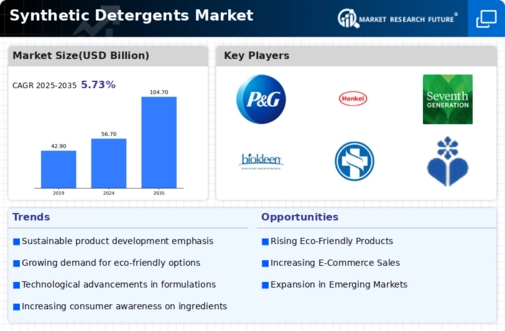E-commerce Growth
The rise of e-commerce significantly impacts the Global Synthetic Detergents Market Industry by providing consumers with greater access to a wide range of products. Online platforms facilitate the purchase of synthetic detergents, allowing consumers to compare brands and prices easily. This convenience is particularly appealing to younger consumers who prefer shopping online. The growth of e-commerce is expected to contribute to the market's expansion, as it enables manufacturers to reach a broader audience. As the market evolves, the integration of digital marketing strategies will likely play a crucial role in driving sales and enhancing brand visibility.
Environmental Regulations
The Global Synthetic Detergents Market Industry is increasingly shaped by stringent environmental regulations aimed at reducing pollution and promoting sustainability. Governments worldwide are implementing policies that encourage the use of biodegradable and eco-friendly cleaning products. This regulatory landscape compels manufacturers to innovate and reformulate their products to comply with these standards. As a result, the market is witnessing a shift towards greener synthetic detergents, which not only meet regulatory requirements but also appeal to environmentally conscious consumers. This trend is likely to enhance the market's growth trajectory in the coming years.
Rising Consumer Awareness
The Global Synthetic Detergents Market Industry experiences a notable increase in consumer awareness regarding the efficacy and environmental impact of cleaning products. As consumers become more informed about the benefits of synthetic detergents, they tend to prefer these products over traditional alternatives. This shift is evidenced by the projected market value of 56.7 USD Billion in 2024, indicating a robust demand driven by informed purchasing decisions. Moreover, consumers are increasingly seeking products that offer superior cleaning performance, which synthetic detergents are known for, thereby further propelling market growth.
Technological Advancements
Technological advancements play a pivotal role in shaping the Global Synthetic Detergents Market Industry. Innovations in formulation and production processes lead to the development of more effective and environmentally friendly synthetic detergents. For instance, the introduction of enzymes and surfactants that enhance cleaning efficiency while reducing water usage has gained traction. These advancements not only cater to the growing demand for sustainable products but also contribute to the market's projected growth, with an anticipated value of 104.7 USD Billion by 2035. The continuous evolution of technology in this sector suggests a dynamic future for synthetic detergents.
Urbanization and Lifestyle Changes
Urbanization and changing lifestyles significantly influence the Global Synthetic Detergents Market Industry. As urban populations grow, the demand for convenient and effective cleaning solutions escalates. Busy lifestyles often lead consumers to seek out synthetic detergents that promise efficiency and ease of use. This trend is reflected in the market's anticipated compound annual growth rate of 5.73% from 2025 to 2035. The increasing number of households in urban areas, coupled with a rising middle class, further drives the demand for synthetic detergents, making them a staple in modern cleaning practices.






















Leave a Comment